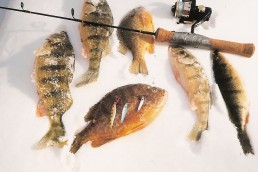Ice Fishing for the Ol’ Man
SHARE THIS POST
If you’re willing to brave the cold weather, Dan Gapen says you can have ice fishing success at any age.
The thermometer registered 18 degrees below zero. With a slight breeze out of the north, it carried a wind chill near 25 degrees below. The ride out with the portable ice shelter was extremely cold. Snow had begun, and both of us soon became coated with ice and snow.
Telling “Bobber” Anne that I was too old for this kind of ice fishing adventure only brought laughter from her ice-covered lips. I wasn’t going to get any sympathy from my partner. It was grin-and-bear-it this day.
With holes drilled and shelter set by our guide Bob, we finally got a reprieve as the heater glowed red, giving off enough heat to thaw my near-frozen hands.
I asked myself, in my 80s, “What the devil was I doing here?” I impaled a scented Red Ball egg on my 1/32-ounce Flicker. Next, it was dropped through the ice hole into 10 feet of clear water. No sooner had it hit bottom and raised slightly, when it was struck. Moments later, a 12-inch perch came flopping through the hole. Maybe this wasn’t going to be too bad after all?!
Sitting next to me on a portable chair, Anne said something that sounded like “fish hog” through her still scarf-wrapped mouth. Aha—the ride out had chilled her, too, but she just wasn’t going to admit it!
Bob had dropped the lens of our underwater camera down about the time Anne hit into the next fish, which turned out to be a nice bluegill. Amazingly, the viewfinder on the camera showed a dozen or more perch gathered around the sand boil created by our jigs hitting bottom. Unknowingly, both of us had triggered the panfish schools below us to race in on our jig presentation, by bouncing them off the loam and sand bottom. It was a tip that our guide was in the process of telling us as our jigs were dropped.
Tip: When angling for perch beneath the ice, drop your lure directly into the bottom sand. This causes a sand boil to come up, which is a signal that draws fish in. Why? Apparently, these fish believe the boil is other fish feeding.
“Guys, raise your jigs out of the sand boil very slowly for about 3 feet. This will entice the hesitant feeders to think your jig is getting away from them,” instructed Bob. “About 75 percent of your strikes will be on the rising lure.
Are you enjoying this post?
You can be among the first to get the latest info on where to go, what to use and how to use it!
“Next, drop your jig down hard, twitch it hard a couple times, and raise it slowly again. Then repeat the process a couple more times,” came Bob’s final advice.
It was great advice, as we watched fresh perch schools coming in. This spot produced 37 fat, 10- to 13-inch perch in the next three hours. At that point, we gave this spot a rest while we ate lunch.
Instead of moving, Anne and I were instructed to drop our Flicker and Red Ball presentations once again. This time we twitched our lures as they descended to bottom. This, we were told, would gain the attention of any newly arrived schools of panfish. That is, unless an 8-pound pike had moved in, attracted by the flash of the twitching 1/32-ounce Flicker.
Before Anne’s presentation reached bottom, a pike hit. The fight was on! On 6-pound mono and a soft, light-action 24-inch ice rod, it turned out to be quite the battle. After the pike’s fourth run, it came willingly to the ice hole. Quick of hand, Anne managed to pinch its gills shut, which temporarily subdued the pike. With a hardy “hoot,” my partner brought Mr. Pike up out of the hole. Video for our TV show was taken and the pike released.
The Marcum underwater screen had showed perch scattering as the pike was fought. Now, schools began to pass by. We dropped and created sand boils, and the fun began once again. Using our new technique, we managed to fill our limits in the next 2 hours. Anything under 11 inches was tossed back; only the 11- to 13-inchers were kept. One near 14 inches was enticed by Anne. She had big fish of the day twice over, after landing that 14-incher!
The plus of the whole adventure was that we hadn’t had to move, and I was warm through the entire period. And that we’d learned several new ways to work panfish under the ice.
Who cared if she had caught the two biggest fish? Summer was coming, and we’d fight the “battle of biggest fish” over again. It could be my time to shine. “Bobber” Anne, you’re in for a battle on fish opener!
Learn how to get the most out of every ice fishing outing. Read the January issue of MidWest Outdoors, available the first full week of January at the newsstand or by subscribing on our website.
MWO
SHARE THIS POST
You may also like...
Nothing found.
Did you enjoy this post?
You can be among the first to get the latest info on where to go, what to use and how to use it!
Dan Gapen
Considered one of the world’s leading river anglers, Dan Gapen, Sr. has shared his knowledge with MidWest Outdoors readers and viewers for more than 40 years. He is a member of all three Fishing Halls of Fame—International, National Freshwater, and Minnesota. He has an immense grasp of the world’s fisheries. He may be contacted at 877-623-2099.
@TheGapenCompany.
